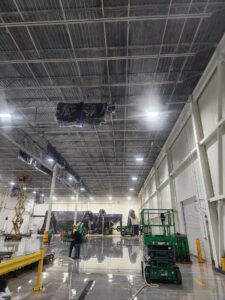
Photo courtesy CGS
Protecting the underside of a metal roof is often not more than a second thought. After all, the ceiling is inside the structure, protected from sun, rain, and snow. But the story takes a different turn when that metal roof covers a factory filled with steam, salt, acidic foods, harsh chemicals, or other corrosives used in the manufacturing process. Pickle factories, sauerkraut plants, or paper mills are just some of the industrial settings where metal ceilings may be under attack from the inside as much as (if not more than) the outside. For any plant “in a pickle” like this, an extra coat or two of protective paint may be just what is needed for enhanced chemical and corrosion resistance.
Choosing the right paint
Selecting the right protective coating is an important step that involves careful consideration. Most importantly, the corrosion and chemical resistance of the paint should match the severity of the environment. It is helpful to look at the salt spray and/or chemical resistance ratings on a product’s data sheet for a better idea of how tough the coating will be. Although these numbers cannot give a perfect answer to how long a coating will last in the field, they allow users to compare which paints offer a higher or lower degree of protection. Since overhead applications create more drip hazards, another good characteristic to look for is good sag resistance. Water-based as well as solvent-based coatings should also be considered, since many user-friendly options with lower volatile organic compounds (VOCs) and good protection now exist.
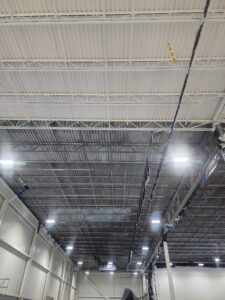
Photo courtesy CGS
Surface prep is king
No matter how good the paint is, without the right surface prep, it may fail prematurely. Cleaning is imperative—especially for new metal ceilings that may be coated with a factory-applied rust preventative. Whether greasy or dry, these rust preventatives do not last as long as permanent coatings and will interfere with paint adhesion if not removed. Pressure washing the metal with a cleaner that contains flash rust inhibitors is a great way to remove grease, rust preventatives, or other surface debris while also protecting the freshly exposed metal from the flash rust that naturally tends to form.
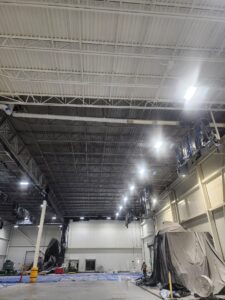
It is also critical to address existing rust; otherwise, the corrosion will continue to spread and eventually bleed through the paint, causing it to fail. Since sandblasting can be more challenging in an overhead manufacturing setting, it is beneficial to have the option of removing loose rust by water- or ice-blasting before applying a rust-converting primer to the remaining rust. Additionally, because rust converting primer is designed to adhere to rough surfaces, and undamaged metal roofing is extremely smooth, any non-rusted areas to which the rust converting primer will be applied should also be blasted.
The same smoothness of new metal can raise adhesion issues for topcoats, so a wash primer with special chemicals that help it latch onto smooth metal surfaces is typically needed to prepare the way for good topcoat adhesion on metal ceilings.
Apply it right the first time
How a coating is applied can be just as important as choosing the right coating and surface prep. If applied too thinly, the paint may not provide the expected level of protection. If applied too thickly, the coating may not dry or cure properly, resulting in mud cracking or pinholes. Proper curing is paramount; without it, the topcoat will not adhere properly, causing the whole coating system to fail.
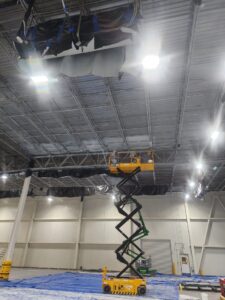
Photo courtesy CGS
Restoring a pickle factory ceiling
Insights can be taken from a strong example of how coatings were used to address corrosion on the ceiling of a pickle factory. Although the structure was relatively young, patches of rust had begun to form on the ceiling of a cold storage room due to the presence of corrosives such as pickle brine (containing salt and vinegar). The pickle plant had successfully used a rust-converting primer in their brine room a few years earlier, and it still looked in excellent condition, so the same rust-converting primer was applied to 1,858 m² (20,000 sf) of metal ceiling above their cool storage area.
In late 2024, the pickle factory moved everything out of the production hall and blasted the ceiling with dry ice. The process moved on to finishing masking and starting painting. They applied 125 µm (5 mils) dry film thickness (DFT) of rust converting primer and let it cure for three days before applying a white water-based corrosion inhibiting topcoat at 75 µm (3 mils) DFT over 650 m² (7,000 sf) of ceiling in the pickle packing area. The plant needed to minimize light reflection in the cold storage area to avoid changes in pickle color, so though applying a permanent topcoat over all primed surfaces for extended protection was recommended, the pickle company was satisfied to leave the rest of the rust-converting primer uncoated.
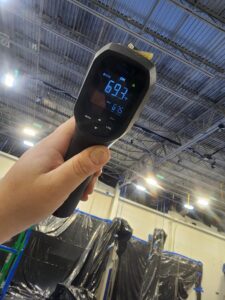
Photo courtesy CGS
The final process included mixing paint and using scissor lifts to reach the 10 m (33 ft) high ceiling, which was then painted with airless sprayers. The ambient temperature was kept in the range of 16 to 21 C (60 to 70 F) during application for good drying and curing.
Get “out of a pickle”
Facilities with a corrosive processing environment will naturally face higher risks for corrosion on metal ceilings. With the right paint, surface prep, and application, even pickle factories can find their way “out of a pickle” and on the path to a longer service life for metal ceilings.
Special thanks to Larry Mudd and David Broussard of CGS (www.cortecgs.com) for sharing the story of the pickle factory ceiling restoration.
Julie Holmquist (marketing content writer) and Jake Hemberger (coatings chemist) work at Cortec Corporation (https://www.cortecvci.com/), a manufacturer of hundreds of corrosion-inhibiting products, including rust-converting primer and corrosion-inhibiting topcoats.


